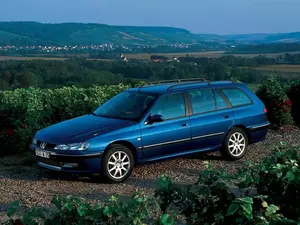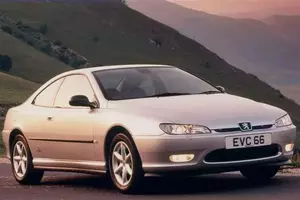
| Vehicle | Curb weight | Difference from world's smallest | Weight to power ratio | 0—60 mph acceleration ratio | Consumption ratio |
|---|---|---|---|---|---|
| 2.0 HDI FAP |
1514 kg / 3338 lbs |
1089 kg (2401 lbs) heavier | 14 kg to 1 hp | 140 kg/s (309 lbs/s) |
266 kg/L (587 lbs/L) |
| 3.0 24V |
1540 kg / 3396 lbs |
1115 kg (2459 lbs) heavier | 8 kg to 1 hp | 190 kg/s (419 lbs/s) | - |
| 3.0 V6 |
1505 kg / 3319 lbs |
1080 kg (2382 lbs) heavier | 7 kg to 1 hp | 186 kg/s (410 lbs/s) | - |
| 1.8 i 16V |
1365 kg / 3010 lbs |
940 kg (2073 lbs) heavier | 12 kg to 1 hp | 116 kg/s (256 lbs/s) | - |
| 1.8 16V |
1310 kg / 2889 lbs |
885 kg (1952 lbs) heavier | 12 kg to 1 hp | 109 kg/s (240 lbs/s) |
154 kg/L (340 lbs/L) |
| 2.0 16V |
1420 kg / 3131 lbs |
995 kg (2194 lbs) heavier | 11 kg to 1 hp | 137 kg/s (302 lbs/s) | - |
| 2.0 HDI 90 |
1460 kg / 3219 lbs |
1035 kg (2282 lbs) heavier | 16 kg to 1 hp | 120 kg/s (265 lbs/s) | - |
| 2.0 HPi |
1400 kg / 3087 lbs |
975 kg (2150 lbs) heavier | 10 kg to 1 hp | 136 kg/s (300 lbs/s) |
182 kg/L (401 lbs/L) |
| 2.0 Turbo |
1460 kg / 3219 lbs |
1035 kg (2282 lbs) heavier | 10 kg to 1 hp | 145 kg/s (320 lbs/s) | - |
| 2.0 HDI 109 |
1460 kg / 3219 lbs |
1035 kg (2282 lbs) heavier | 13 kg to 1 hp | 120 kg/s (265 lbs/s) | - |
| 2.2 16V |
1500 kg / 3308 lbs |
1075 kg (2371 lbs) heavier | 9 kg to 1 hp | 155 kg/s (342 lbs/s) |
169 kg/L (373 lbs/L) |
| 2.2 HDi |
1460 kg / 3219 lbs |
1035 kg (2282 lbs) heavier | 11 kg to 1 hp | 136 kg/s (300 lbs/s) |
225 kg/L (496 lbs/L) |
| Vehicle | 2.0 HDI FAP |
|---|---|
| Curb weight |
1514 kg / 3338 lbs |
| Difference from world's smallest | 1089 kg (1089 lbs) heavier |
| Weight to power ratio | 14 kg to 1 hp |
| 0—60 mph acceleration ratio | 140 kg/s (309 lbs/s) |
| Consumption ratio |
266 kg/L (587 lbs/L) |
| Vehicle | 3.0 24V |
| Curb weight |
1540 kg / 3396 lbs |
| Difference from world's smallest | 1115 kg (1115 lbs) heavier |
| Weight to power ratio | 8 kg to 1 hp |
| 0—60 mph acceleration ratio | 190 kg/s (419 lbs/s) |
| Consumption ratio | - |
| Vehicle | 3.0 V6 |
| Curb weight |
1505 kg / 3319 lbs |
| Difference from world's smallest | 1080 kg (1080 lbs) heavier |
| Weight to power ratio | 7 kg to 1 hp |
| 0—60 mph acceleration ratio | 186 kg/s (410 lbs/s) |
| Consumption ratio | - |
| Vehicle | 1.8 i 16V |
| Curb weight |
1365 kg / 3010 lbs |
| Difference from world's smallest | 940 kg (940 lbs) heavier |
| Weight to power ratio | 12 kg to 1 hp |
| 0—60 mph acceleration ratio | 116 kg/s (256 lbs/s) |
| Consumption ratio | - |
| Vehicle | 1.8 16V |
| Curb weight |
1310 kg / 2889 lbs |
| Difference from world's smallest | 885 kg (885 lbs) heavier |
| Weight to power ratio | 12 kg to 1 hp |
| 0—60 mph acceleration ratio | 109 kg/s (240 lbs/s) |
| Consumption ratio |
154 kg/L (340 lbs/L) |
| Vehicle | 2.0 16V |
| Curb weight |
1420 kg / 3131 lbs |
| Difference from world's smallest | 995 kg (995 lbs) heavier |
| Weight to power ratio | 11 kg to 1 hp |
| 0—60 mph acceleration ratio | 137 kg/s (302 lbs/s) |
| Consumption ratio | - |
| Vehicle | 2.0 HDI 90 |
| Curb weight |
1460 kg / 3219 lbs |
| Difference from world's smallest | 1035 kg (1035 lbs) heavier |
| Weight to power ratio | 16 kg to 1 hp |
| 0—60 mph acceleration ratio | 120 kg/s (265 lbs/s) |
| Consumption ratio | - |
| Vehicle | 2.0 HPi |
| Curb weight |
1400 kg / 3087 lbs |
| Difference from world's smallest | 975 kg (975 lbs) heavier |
| Weight to power ratio | 10 kg to 1 hp |
| 0—60 mph acceleration ratio | 136 kg/s (300 lbs/s) |
| Consumption ratio |
182 kg/L (401 lbs/L) |
| Vehicle | 2.0 Turbo |
| Curb weight |
1460 kg / 3219 lbs |
| Difference from world's smallest | 1035 kg (1035 lbs) heavier |
| Weight to power ratio | 10 kg to 1 hp |
| 0—60 mph acceleration ratio | 145 kg/s (320 lbs/s) |
| Consumption ratio | - |
| Vehicle | 2.0 HDI 109 |
| Curb weight |
1460 kg / 3219 lbs |
| Difference from world's smallest | 1035 kg (1035 lbs) heavier |
| Weight to power ratio | 13 kg to 1 hp |
| 0—60 mph acceleration ratio | 120 kg/s (265 lbs/s) |
| Consumption ratio | - |
| Vehicle | 2.2 16V |
| Curb weight |
1500 kg / 3308 lbs |
| Difference from world's smallest | 1075 kg (1075 lbs) heavier |
| Weight to power ratio | 9 kg to 1 hp |
| 0—60 mph acceleration ratio | 155 kg/s (342 lbs/s) |
| Consumption ratio |
169 kg/L (373 lbs/L) |
| Vehicle | 2.2 HDi |
| Curb weight |
1460 kg / 3219 lbs |
| Difference from world's smallest | 1035 kg (1035 lbs) heavier |
| Weight to power ratio | 11 kg to 1 hp |
| 0—60 mph acceleration ratio | 136 kg/s (300 lbs/s) |
| Consumption ratio |
225 kg/L (496 lbs/L) |

| Vehicle | Curb weight | Difference from world's smallest | Weight to power ratio | 0—60 mph acceleration ratio | Consumption ratio |
|---|---|---|---|---|---|
| 3.0 V6 |
1455 kg / 3208 lbs |
1030 kg (2271 lbs) heavier | 7 kg to 1 hp | 189 kg/s (417 lbs/s) | - |
| 1.6 |
1315 kg / 2900 lbs |
890 kg (1963 lbs) heavier | 15 kg to 1 hp | 88 kg/s (194 lbs/s) |
171 kg/L (377 lbs/L) |
| 2.0 |
1315 kg / 2900 lbs |
890 kg (1963 lbs) heavier | 10 kg to 1 hp | 125 kg/s (276 lbs/s) |
145 kg/L (320 lbs/L) |
| 2.0 HDI 90 |
1330 kg / 2933 lbs |
905 kg (1996 lbs) heavier | 15 kg to 1 hp | 96 kg/s (212 lbs/s) |
238 kg/L (525 lbs/L) |
| 2.0 HPi |
1340 kg / 2955 lbs |
915 kg (2018 lbs) heavier | 10 kg to 1 hp | 133 kg/s (293 lbs/s) |
179 kg/L (395 lbs/L) |
| 2.1 TD 12V |
1415 kg / 3120 lbs |
990 kg (2183 lbs) heavier | 13 kg to 1 hp | 119 kg/s (262 lbs/s) |
214 kg/L (472 lbs/L) |
| 2.0 Turbo |
1410 kg / 3109 lbs |
985 kg (2172 lbs) heavier | 10 kg to 1 hp | 144 kg/s (318 lbs/s) | - |
| 2.2 HDi |
1410 kg / 3109 lbs |
985 kg (2172 lbs) heavier | 11 kg to 1 hp | 134 kg/s (295 lbs/s) |
220 kg/L (485 lbs/L) |
| 2.2 16V |
1370 kg / 3021 lbs |
945 kg (2084 lbs) heavier | 9 kg to 1 hp | 144 kg/s (318 lbs/s) |
154 kg/L (340 lbs/L) |
| Vehicle | 3.0 V6 |
|---|---|
| Curb weight |
1455 kg / 3208 lbs |
| Difference from world's smallest | 1030 kg (1030 lbs) heavier |
| Weight to power ratio | 7 kg to 1 hp |
| 0—60 mph acceleration ratio | 189 kg/s (417 lbs/s) |
| Consumption ratio | - |
| Vehicle | 1.6 |
| Curb weight |
1315 kg / 2900 lbs |
| Difference from world's smallest | 890 kg (890 lbs) heavier |
| Weight to power ratio | 15 kg to 1 hp |
| 0—60 mph acceleration ratio | 88 kg/s (194 lbs/s) |
| Consumption ratio |
171 kg/L (377 lbs/L) |
| Vehicle | 2.0 |
| Curb weight |
1315 kg / 2900 lbs |
| Difference from world's smallest | 890 kg (890 lbs) heavier |
| Weight to power ratio | 10 kg to 1 hp |
| 0—60 mph acceleration ratio | 125 kg/s (276 lbs/s) |
| Consumption ratio |
145 kg/L (320 lbs/L) |
| Vehicle | 2.0 HDI 90 |
| Curb weight |
1330 kg / 2933 lbs |
| Difference from world's smallest | 905 kg (905 lbs) heavier |
| Weight to power ratio | 15 kg to 1 hp |
| 0—60 mph acceleration ratio | 96 kg/s (212 lbs/s) |
| Consumption ratio |
238 kg/L (525 lbs/L) |
| Vehicle | 2.0 HPi |
| Curb weight |
1340 kg / 2955 lbs |
| Difference from world's smallest | 915 kg (915 lbs) heavier |
| Weight to power ratio | 10 kg to 1 hp |
| 0—60 mph acceleration ratio | 133 kg/s (293 lbs/s) |
| Consumption ratio |
179 kg/L (395 lbs/L) |
| Vehicle | 2.1 TD 12V |
| Curb weight |
1415 kg / 3120 lbs |
| Difference from world's smallest | 990 kg (990 lbs) heavier |
| Weight to power ratio | 13 kg to 1 hp |
| 0—60 mph acceleration ratio | 119 kg/s (262 lbs/s) |
| Consumption ratio |
214 kg/L (472 lbs/L) |
| Vehicle | 2.0 Turbo |
| Curb weight |
1410 kg / 3109 lbs |
| Difference from world's smallest | 985 kg (985 lbs) heavier |
| Weight to power ratio | 10 kg to 1 hp |
| 0—60 mph acceleration ratio | 144 kg/s (318 lbs/s) |
| Consumption ratio | - |
| Vehicle | 2.2 HDi |
| Curb weight |
1410 kg / 3109 lbs |
| Difference from world's smallest | 985 kg (985 lbs) heavier |
| Weight to power ratio | 11 kg to 1 hp |
| 0—60 mph acceleration ratio | 134 kg/s (295 lbs/s) |
| Consumption ratio |
220 kg/L (485 lbs/L) |
| Vehicle | 2.2 16V |
| Curb weight |
1370 kg / 3021 lbs |
| Difference from world's smallest | 945 kg (945 lbs) heavier |
| Weight to power ratio | 9 kg to 1 hp |
| 0—60 mph acceleration ratio | 144 kg/s (318 lbs/s) |
| Consumption ratio |
154 kg/L (340 lbs/L) |

| Vehicle | Curb weight | Difference from world's smallest | Weight to power ratio | 0—60 mph acceleration ratio | Consumption ratio |
|---|---|---|---|---|---|
| 3.0 V6 24V |
1458 kg / 3215 lbs |
1033 kg (2278 lbs) heavier | 8 kg to 1 hp | 194 kg/s (428 lbs/s) | - |
| 3.0 V6 |
1505 kg / 3319 lbs |
1080 kg (2382 lbs) heavier | 7 kg to 1 hp | 203 kg/s (448 lbs/s) | - |
| 2.2 16V |
1420 kg / 3131 lbs |
995 kg (2194 lbs) heavier | 9 kg to 1 hp | 151 kg/s (333 lbs/s) | - |
| 2.0 16V |
1385 kg / 3054 lbs |
960 kg (2117 lbs) heavier | 10 kg to 1 hp | 140 kg/s (309 lbs/s) | - |
| 2.2 HDi |
1410 kg / 3109 lbs |
985 kg (2172 lbs) heavier | 11 kg to 1 hp | 136 kg/s (300 lbs/s) |
220 kg/L (485 lbs/L) |
| Vehicle | 3.0 V6 24V |
|---|---|
| Curb weight |
1458 kg / 3215 lbs |
| Difference from world's smallest | 1033 kg (1033 lbs) heavier |
| Weight to power ratio | 8 kg to 1 hp |
| 0—60 mph acceleration ratio | 194 kg/s (428 lbs/s) |
| Consumption ratio | - |
| Vehicle | 3.0 V6 |
| Curb weight |
1505 kg / 3319 lbs |
| Difference from world's smallest | 1080 kg (1080 lbs) heavier |
| Weight to power ratio | 7 kg to 1 hp |
| 0—60 mph acceleration ratio | 203 kg/s (448 lbs/s) |
| Consumption ratio | - |
| Vehicle | 2.2 16V |
| Curb weight |
1420 kg / 3131 lbs |
| Difference from world's smallest | 995 kg (995 lbs) heavier |
| Weight to power ratio | 9 kg to 1 hp |
| 0—60 mph acceleration ratio | 151 kg/s (333 lbs/s) |
| Consumption ratio | - |
| Vehicle | 2.0 16V |
| Curb weight |
1385 kg / 3054 lbs |
| Difference from world's smallest | 960 kg (960 lbs) heavier |
| Weight to power ratio | 10 kg to 1 hp |
| 0—60 mph acceleration ratio | 140 kg/s (309 lbs/s) |
| Consumption ratio | - |
| Vehicle | 2.2 HDi |
| Curb weight |
1410 kg / 3109 lbs |
| Difference from world's smallest | 985 kg (985 lbs) heavier |
| Weight to power ratio | 11 kg to 1 hp |
| 0—60 mph acceleration ratio | 136 kg/s (300 lbs/s) |
| Consumption ratio |
220 kg/L (485 lbs/L) |